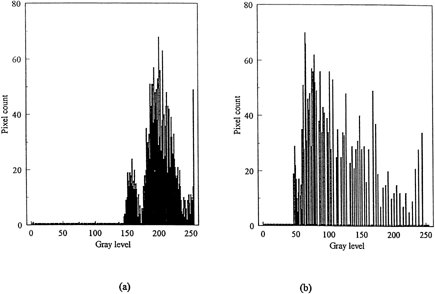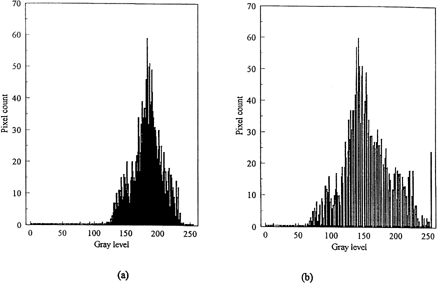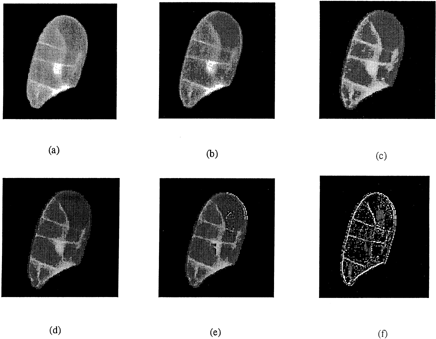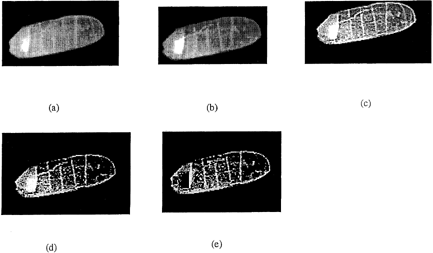ABSTRACT
Rapid moisture adsorption by low-moisture rice grains may cause the grains to fissure. The combination of physical properties such as stress and strain has a continuous influence on the rice grain. Rice grains with stress fissures break more readily than sound kernels during harvesting, handling, milling, and transporting, and thereby reduce the quality and market value of the rice grain. Stress fissure detection remains one of the most important tasks in rice grain quality inspection. A machine vision system was used to obtain images of fissured rice grains. The system consisted of a CCD (Charge Coupled Device) black/white camera, an image frame grabber, and a computer. An image processing program (Image-Pro Plus) was used to study and evaluate the images. The procedures to detect fissures in rice grain using Image-Pro Plus were developed. The fissure pattern difference between long and medium grain rice was recognized after analyzing the processed images of the fissured grains. The computer vision system with Image-Pro Plus used in our study was able to reveal 94% of all the fissure lines detected in medium rice samples by a human expert and 100% in long rice samples.
INTRODUCTION
Rice grains are hygroscopic and respond dynamically and physically to moisture and temperature changes in the environment. Low-moisture rice grains will fissure when such grains are exposed to a high relative humidity (RH) environment in which moisture is adsorbed Citation[1]. Rice grains with stress fissures break more readily than sound kernels during harvesting, handling, milling, and transporting, and thereby reduce the quality and market value of the grain. Stress fissure detection remains one of the most important tasks in rice grain quality inspection. Different types of rice grains (long, medium, and short) may not have the same pattern of fissures when such grains are exposed to a high RH environment. Pattern recognition may be defined as the categorization of shape descriptor data into identifiable classes Citation[2]. Pattern recognition is used to detect, define, and extract common features which describe objects belonging to the same pattern class. Pattern recognition and digital image processing methods are described in detail by Tou and Gonzalez Citation[3], Batchelor Citation[4], and Gonzalez and Woods Citation[5].
Stress cracks, caused by a combination of thermal, moisture, and mechanical stresses, are internal and not readily identifiable. Rice kernels are examined for stress cracks manually by candling the kernels with a fiber optic source from below Citation[1]. Most of the evaluation methods involve a candling procedure (light transmission) to observe the stress cracks, or milling tests to determine head rice yields Citation[6]. This procedure is slow, labor intensive, and difficult in situations where the inspection task is repeated on a routine basis. Furthermore, rice kernels are irregular in shape, composite and anisotropic, non-uniform and non-homogeneous making fissure detection more complicated. Use of machine vision for detection of stress cracks allows to develop an easy, objective, and more consistent detection method.
Machine vision is a developing technology, although it has many practical applications. One of the most common adaptations of machine vision is in the area of inspection tasks, which includes surface flaw detection, dimensional tolerance verification, and shape verification Citation[7]. Gunasekaran and Paulsen Citation[8] reported that the stress cracks caused transmitted light to diffuse more readily at the sides of kernels than at the center unlike the sound kernels. Differences in illumination appear as significant intensity changes across the stress cracks in corn kernel images. For automated detection of stress cracks, a computer vision system has been developed to analyze a corn kernel image and characterize significant intensity changes as related to the stress cracks Citation[9]. Elster and Goodrum Citation[10] used machine vision to detect cracks in eggs. They found that back-lighting using a Speed-king lamp produced the best contrast between the cracks and the rest of the surface of the egg. The image analysis program performed well in that it could correctly determine whether or not an egg was cracked 95.6% of the time on the samples tested. Berman et al. Citation[11] used image analysis of whole-grain samples to predict milling quality in wheat breeding. They found that about 66% of the variation in flour yield for 38 grain samples could be explained by four factors computed from the images of 100 grains for each sample (mean of grain area, lengths of minor and major axes, ellipsoidal volume, and test weight). Zayas and Steel Citation[2] used image analysis in conjunction with statistical pattern recognition to discriminate whole corn from broken corn kernels. Multivariate discriminant analysis was used to develop classification rules to aid in the identification of whole kernels and/or broken kernels. All of the broken and 98% of the whole corn kernels in an independent set of unknown kernels were correctly identified using the developed procedures. Stermer and Kunze Citation[6] developed an acoustical device using a piezoelectric crystal as the sound transducer to detect the sounds made as fissures occurred.
In summary, stress fissure detection in rice grains may be achieved manually by candling the kernels with a light source from below or using an acoustical method. Each system has advantages and disadvantages as stated above. Machine vision method has been investigated to detect stress cracks in corn kernels but not for rice grains. Broken rice grains are a significant loss to rice producers and processors.
The primary objectives of this research were to develop a procedure to detect the presence of fissures in rice grains and to evaluate a machine vision system on the basis of its potential for correctly detecting fissures.
MATERIALS AND METHODS
Lemont, a long grain, and Rico I, a medium grain, were the two rice varieties used in this study. Both were rated as highly susceptible to fissuring by Lan et al. Citation[12]. In spite of Lemont's susceptibility to fissure, its high yield potential makes it a popular commercial variety. Samples were equilibrated to a moisture content of 10.5% (w.b.) in an air-conditioned room. After equilibration of the rice samples, the milled grain rice was sealed in bottles and stored in an air-conditioned room at 58% RH and 20°C.
Long grain cultivars are characterized by high amylose contents (23–27%). Medium grains have much lower amylose contents (15–21%). These differences in amylose content greatly change many other properties of the rice. In our study, different images between long grain rice and medium grain rice were found, hence different image processing procedures had to be used. A static RH system as used by Kunze and Peralta Citation[13] and Lan et al. Citation[12] was used to produce fissures in rice grains.
Vision System
The imaging acquisition hardware used in this study consisted of a Data Translation DT 3155 PCI bus frame grabber board and a GATEWAY 2000 P5-120XL computer. The frame grabber had a spatial resolution of 640 rows×480 columns of pixels with 256 (8 bits) gray levels: 0 for black to 255 for white. GLOBAL LAB Image called GLOBAL LAB Acquire, was used to support continuous and free-frame capture and display, frame grabber setup, file storage and retrieval, and image printing and retrieving systems. The DT3155 frame grabber board can acquire a monochrome video image and transfer the image to memory or display in real time. Images were captured using a SONY XC-77RR CCD video camera (black/white) with a SONY DC-77RR camera adaptor. The camera was mounted on a vertically adjustable precision slide mechanism for focusing on the plane of interest. Gray level images were displayed on a black/white video monitor. The captured images were then processed using Image-Pro Plus Citation[14].
Illumination
The role of illumination in this application was to enhance the visibility of stress cracks in the kernel. Direct-lighting from above and diffused side-lighting were used to illuminate the kernel surface. Back-lighting using a fiber optic source was used to enhance illumination discontinuities resulting from the diffraction of light by stress cracks.
Area and Perimeter Measurements
Area and perimeter are easily determined for specimens with uniform shape. However, rice grain kernels have an irregular shape. In this study, the area and perimeter of each rice grain were automatically determined by the Auto Area feature of Image-Pro Plus. The measurement functions were performed in terms of screen pixel positions. The procedure for calibrating measurements was proposed by Image-Pro Plus. These pixel-level distances then can be scaled to fit any coordinate system. The known measurements in the image were used to calibrate the measurement units because the default unit of measurement was a pixel.
Contrast Enhancement Operations
Gamma correction enhances contrast in an image through non-linear mapping of gray or color component values. Gamma correction curves are standard curves that compensate for differences in responses of input and output devices. By selecting a gamma correction factor, the contrast in the dark areas of the image is changed. The greater the gamma value, the greater the boost in dark areas Citation[14].
Histogram equalization alters the dynamic range and contrast of an image. This operation has the effect of lightening or darkening an overall image, depending on the curve chosen to increase the contrast of an image. The available curves include linear, bell, cube, logarithmic, and exponential in Image-Pro Plus. For medium rice kernels, it was found that the log curve yielded the best contrast of the image.
Filtering Operation
The spatial filtering operations reduce or increase the rate of brightness change in an image. This rate is known as the spatial frequency. In general, spatial filters enhance selected frequency components and remove or suppress all others. The important parts of an image were kept while others were discarded by filtering. For edge detection, high-pass filters should be used because edges consist mainly of high frequency components. Edge filters (e.g., Horizontal Edge, Vertical Edge, and Laplacian) detect the edges in an image Citation[14]. Since filtering is a trial-and-error process, Hi-Pass, Sharpen, and Laplacian filters were used in this study. Hi-Pass and Sharpen filters sharpened images with high-frequency components and accented the image edges. The Laplacian filter was used to remove the low-contrast components and leave only the edges. A morphological filtering option was used to change the shapes of areas within an image by manipulating the light and dark edges. The morphological option in Image-Pro Plus contained erosion, dilation, opening, and closing filters. Erosion was used to erode the edges and generally darken the image because the erosion filter replaced the center pixel index value with the smallest pixel index values in the kernel (3×3, 5×5, or 7×7 matrix of pixels).
Regional Enhancement
Regional enhancement refers to the enhancement operations performed on a partial image instead of the entire image. This technique is useful in enhancing or removing some elements in the image. Since there were some undesired white spots in the original images, which mainly consisted of high frequency components, low-pass filtering operations were applied to those isolated white spots. Afler low-pass filtering, most of the white spots were removed or suppressed.
RESULTS AND DISCUSSION
Rice samples were checked by an on-site expert with a pen flashlight and a petri dish. The samples were brought directly to the machine vision site and imaged so that no further fissures were developed between human and machine vision detecting. The methods developed for the fissure inspection of rice kernels were replicated 50 times on a total of 50 long fissured rice kernels and 50 medium fissured rice kernels in separate experiments.
Area and Perimeter Measurements
Knowledge of the projected area and perimeter of rice grains in a plane parallel to the longitudinal axis of the grain is important in the analysis and prediction of heat and mass transfer processes during moisture adsorption and desorption. The average area and perimeter of the maximum projection in the milled long grain rice kernels were 4960 pixels and 322.2 pixels, respectively. From the calibration, these units were converted to 0.121 cm2 (1.88×10−4 in.2) in area and 1.54 cm (0.606 in.) in perimeter, respectively. The average area and perimeter of the maximum projection in the milled medium grain rice kernels were 5196 pixels and 294.6 pixels, respectively. From the calibration, these units were converted to 0.127 cm2 (1.97×10−4 in.2) in area and 1.41 cm (0.555 in.) in perimeter, respectively.
Procedure for Fissure Detection
Gray level histograms of medium and long grain rice are shown in Figs. and , respectively. Inspection of the histogram showed that the contrast of the original images was poor. A series of image enhancements, as described in the following paragraphs, were used to improve the quality of the images. The brightness and darkness in an image can be measured by contrast. The histogram shows contrast by measuring the variation of indexes. If the vertical lines are grouped closely together, the image has low contrast. If the lines are spread over the entire range, the image has high contrast. The high-pass filtering used in the image processing passes high frequencies in the gray scale value, i.e., it passes the pixels with large change in gray scale value (derivative) in relation to the neighboring pixels but not necessarily those pixels with high gray scale values.
Figure 1. Gray level histogram of medium grain rice: (a) original image; and (b) after gamma correction and histogram equalization.

Figure 2. Gray level histogram of long grain rice: (a) original image; and (b) after gamma correction.

For the histogram of the original medium grain rice image, the values of gray levels were in the range of 150 to 250 (Fig. ). After gamma correction and histogram equalization, the range of the gray levels was stretched to between 50 to 250, which increased the contrast of the image dramatically. For the histogram of the long grain rice image, the range of gray levels for the original image was wider (125 to 250). However, after the image enhancement (gamma correction for long grain rice kernel), the range of gray levels was stretched from 60 to 250.
For medium grain rice samples, the procedure to detect fissures in a rice kernel using Image-Pro Plus included gamma correction, histogram equalization, morphological erosion, regional enhancement, and edge detection. Figure shows the image processing for medium grain rice. In the processed images the outer lines represent the kernel periphery. The stress fissures are represented by the lines inside the rice kernel boundary. The statistical results for gray-scale in Fig. a were 201.9 for the mean, 137 for the minimum, 255 for the maximum, and 24.6 for the standard deviation. The statistical results for gray-scale in Fig. f were 109.4 for the mean, 47 for the minimum, 245 for the maximum, and 49.6 for the standard deviation.
Figure 3. Image representing the classification of stress fissures in medium grain rice images: (a) raw images; (b) image after gamma correction; (c) image after histogram equalization; (d) image after erosion; (e) image after regional enhancement; and (f) image after edge detection.

For long grain rice samples, the procedure to detect fissures in a rice kernel using Image-Pro Plus included gamma correction, high-pass filtering, contrast adjustment, and regional enhancement. Figure shows the image processing for long grain rice. The statistical results for gray-scale in Fig. a were 183.9 for the mean, 78 for the minimum, 240 for the maximum, and 23.5 for the standard deviation. The statistical results for gray-scale in Fig. e were 152.0 for the mean, 12 for the minimum, 255 for the maximum, and 37.8 for the standard deviation.
Fissure Pattern Difference
Most of the fissures in the long grain rice samples were perpendicular to the longitudinal axis of the rice kernels with an occasional fissure parallel to the longitudinal axis of the rice kernels. Most of the fissures from medium grain rice samples were perpendicular to the longitudinal axis of the rice kernels with an occasional and random fissure existing neither parallel or perpendicular to the longitudinal axis of the rice kernels. Lan and Kunze Citation[15] reported that fissures perpendicular to the longitudinal axis of rice kernels were caused by axial stresses from moisture adsorption exceeding tensile strength. Parallel fissures were caused by tangential stresses exceeding tensile strength.
Evaluation of System
The image analysis system was evaluated to determine its performance. The computer vision system with image analysis using the Image-Pro Plus software was able to identify approximately 94% (236 fissured lines detected out of total 251 fissured lines) of all the fissured lines in 50 medium grain rice samples detected by the human expert. All the fissured lines in 50 long grain rice samples detected by the human expert were identified by the machine vision system. Some medium grain rice samples became chalky and were more difficult to recognize the fissure lines by machine vision system and software than long grain rice.
Fissures in a rice kernel were relatively easy to detect compared to cracks in a corn kernel. The pixels representing stress fissures for rice grains after the image processing steps had significantly different gray scale values than the pixels representing the rest of the kernel surface. The faint ends of the stress fissures were not obtained as lines because fissures in a rice kernel did not completely transcend the cross-section of the rice kernel. If a fissure had completely transcended the cross-section of the kernel, the kernel would have fallen apart because there would have been no structural component to hold the grain together Citation[15].
CONCLUSIONS
These series of experiments and image analyses demonstrated the potential of using machine vision technology for detecting fissures in rice grain inspection. For medium grain rice samples, the procedure to detect fissures in a rice kernel using Image-Pro Plus included gamma correction, histogram equalization, morphological erosion, regional enhancement, and edge detection. For long grain rice samples, the procedure to detect fissures in a rice kernel using Image-Pro Plus included gamma correction, high-pass filtering, contrast adjustment, and regional enhancement. The computer vision system with image analysis using the Image-Pro Plus software was able to identify 94% (236 fissured lines detected out of total 251 fissured lines) of all the fissured lines in 50 medium grain rice samples detected by the human expert. All the fissured lines in 50 long grain rice samples detected by the human expert were identified by the machine vision system. The limitation using Image-Pro Plus software to detect fissure lines in rice grains is the execution time dependent on the PC CPU speed and software features. Further research needs to be done to use more rice varieties.
Acknowledgments
REFERENCES
- Lan , Y. and Kunze , O.R. 1996a . Relative Humidity Effects on the Development of Fissures in Rice . Cereal Chemistry , 73 ( 2 ) : 222 – 224 .
- Zayas , I.H. and Steele , J. 1990 . Discrimination of Whole from Broken Corn Kernels with Image Analysis . Transactions of the ASAE , 33 ( 5 ) : 1642 – 1646 .
- Tou , J.T. and Gonzalez , R.C. 1974 . Pattern Recognition Principles MA : Addison-Wesley Publishing: Reading .
- Batchelor , B.G. 1978 . Pattern Recognition: Ideas in Practice New York : Plenum Press .
- Gonzalez , R.C. and Woods , R.E. 1993 . Digital Image Processing MA : Addison-Wesley Publishing: Reading .
- Stermer , R.A. and Kunze , O.R. 1994 . Acoustical Detection of Fissures in Rice . Applied Engineering in Agriculture , 10 ( 2 ) : 267 – 271 .
- Fant , E. , Casady , W. , Goh , D. and Siebenmorgen , T. 1994 . Grey-scale Intensity as a Potential Measurement for Degree of Rice Milling . Journal of Agricultural Engineering , 58 : 89 – 97 .
- Gunasekaran , S. and Paulsen , M.R. 1986 . “ Automatic, Nondestructive Detection of Corn Kernel Defects ” . In International Advances in Nondestructive Testing Vol. 12 , 95 – 116 . New York : Gorden and Breach Science Publishers .
- Reid , J.F. , Kim , C. and Paulsen , M.R. 1991 . Computer Vision Sensing of Stress Cracks in Corn Kernels . Transactions of the ASAE , 34 ( 5 ) : 2236 – 2244 .
- Elster , R.T. and Goodrum , J.W. 1991 . Detection of Cracks in Eggs Using Machine Vision . Transactions of the ASAE , 34 ( 1 ) : 307 – 312 .
- Berman , M. , Bason , M.L , Ellison , F. , Peden , G. and Wrigley , C.W. 1996 . Image Analysis of Whole Grains to Screen for Flour-milling Yield in Wheat Breeding . Cereal Chemistry , 73 ( 3 ) : 323 – 327 .
- Lan , Y. , Kunze , O.R. and Bollich , C.N. 1996 . Fissure Resistance of Rice Varieties . Applied Engineering in Agriculture , 12 ( 3 ) : 365 – 368 .
- Kunze , O.R. and Peralta , E.K. 1993 . Practical Relative Humidity Systems that Fissure Rice and Other Grains . Applied Engineering in Agriculture , 9 ( 1 ) : 85 – 89 .
- Image-Pro Plus. Reference Guide v2.0. Media Cybernetics. Silver Spring, MD
- Lan , Y. and Kunze , O.R. 1996b . Fissure Characteristics Related to Moisture Adsorption Stresses in Rice . Transactions of the ASAE , 39 ( 6 ) : 2169 – 2l74 .
